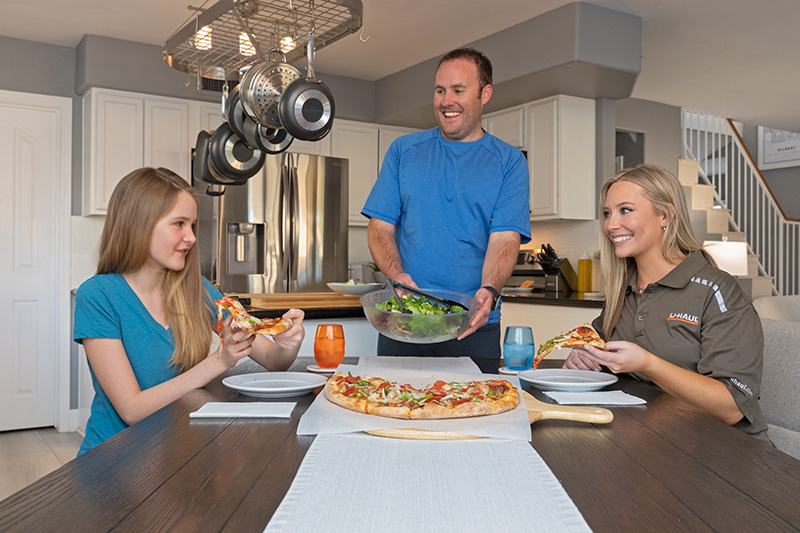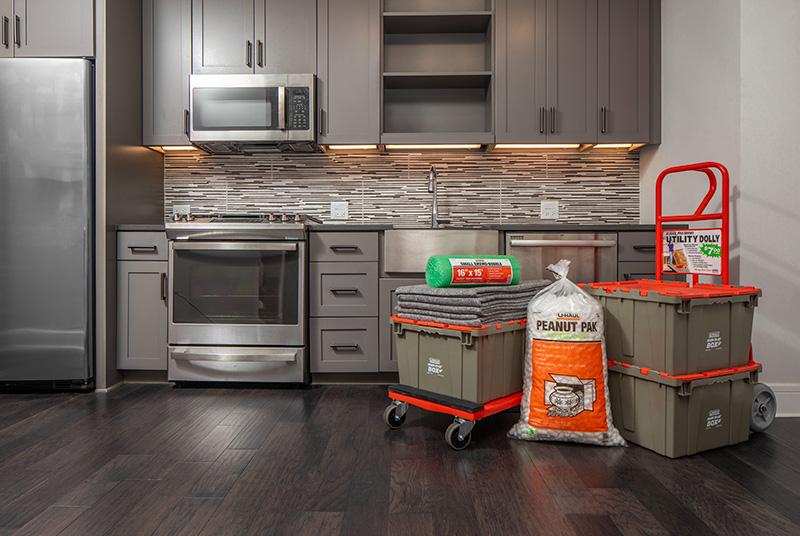Kitchens often become the hub of our homes, hosting impromptu gatherings and daily meal creation. So, for our summer organization and self-storage series, we will start things off by providing some organization tips for this very room.
Pantry: If you have a pantry, or special cabinet for dry storage of food such as cereal, noodles and canned foods, you can likely relate to the need for organization in this space. Dry foods can be stored in a variety of ways to maximize space and increase visibility so that nothing gets lost in the back corners. Begin by removing all contents from the pantry and organizing them by either food type (snacks, baking, spices, etc.), or size (cans, boxes, etc.). This will help you determine how to organize the pantry based on the amount of items you have. Put items that are rarely used, such as party supplies in a clear storage container and store on the higher shelves or in an unused storage closet. Check expiration dates on all items before replacing them in the pantry. Place items with the nearest “use by” date toward the front, so you remember to use it, or donate to your local food bank. Consider removing foods from their original packaging and placing them into clear canisters and containers that fit nicely together to maximize space. You can even add labels to your containers for quick reference. If your shelves are particularly tall, adding additional shelving to break it up will help you make better use of the available vertical space.
 Countertop: Countertops can be a tricky area to organize because they are on display for you, and everyone else, to see. The key here is to keep just the basic necessities on the counter (i.e.: items you use daily) and store the rest below in cabinets to avoid a cluttered look. A few decorative accessories are fine but opt for items that offer both form and function (for example, a decorative vase that also holds cooking utensils). However, small appliances that are used once in a while should be stored in the cabinets above or below.
Countertop: Countertops can be a tricky area to organize because they are on display for you, and everyone else, to see. The key here is to keep just the basic necessities on the counter (i.e.: items you use daily) and store the rest below in cabinets to avoid a cluttered look. A few decorative accessories are fine but opt for items that offer both form and function (for example, a decorative vase that also holds cooking utensils). However, small appliances that are used once in a while should be stored in the cabinets above or below.
Cabinets: Cabinets can become full very quickly, housing everything from dishes to pots and pans. Go through your cabinets and make sure that what you are hanging onto you are actually using (remember when you thought you would start juicing every day but haven’t touched the machine since the ’90’s?). If you come across some items you aren’t using, prepare them for a yard sale (we will talk about the best way to have a yard sale during a later post). If you are holding on to some items for a sentimental reason, such as your grandmother’s fine china, you can pack these items up to store them out of the way. Use a dish saver kit for safe and easy storing (see the best way to pack dishes for storage here). If you find you are low on storage space you can add more by mounting a couple of small hooks to the inside of kitchen and cabinet doors to hold measuring spoons, potholders, and other small items that always get lost in the drawer.
 Refrigerator: Last, but certainly not least, the fridge is a very important (and often overlooked) area to organize. Start by straightening each shelf in your refrigerator, purging old food and moving vegetables and fruits back into their proper bins. Make sure items are on the shelves by height to maximize storage space (source: How to Declutter the Kitchen). Consider keeping a permanent marker by the refrigerator and add a date to the top of containers when they are opened, for example, boxed broths, ketchup, peanut butter, and other condiments and spices. Utilize Plastic Storage bags for storing leftovers, meats, sauces, and soups in the freezer. Lay these bags flat to maximize storage space.
Refrigerator: Last, but certainly not least, the fridge is a very important (and often overlooked) area to organize. Start by straightening each shelf in your refrigerator, purging old food and moving vegetables and fruits back into their proper bins. Make sure items are on the shelves by height to maximize storage space (source: How to Declutter the Kitchen). Consider keeping a permanent marker by the refrigerator and add a date to the top of containers when they are opened, for example, boxed broths, ketchup, peanut butter, and other condiments and spices. Utilize Plastic Storage bags for storing leftovers, meats, sauces, and soups in the freezer. Lay these bags flat to maximize storage space.
With the four main storage areas of the kitchen covered above, you are on your way to getting things in order and feeling much more at ease. Join us next week when we will reveal some of the best tips for getting organized in the places you store all of the small things.



